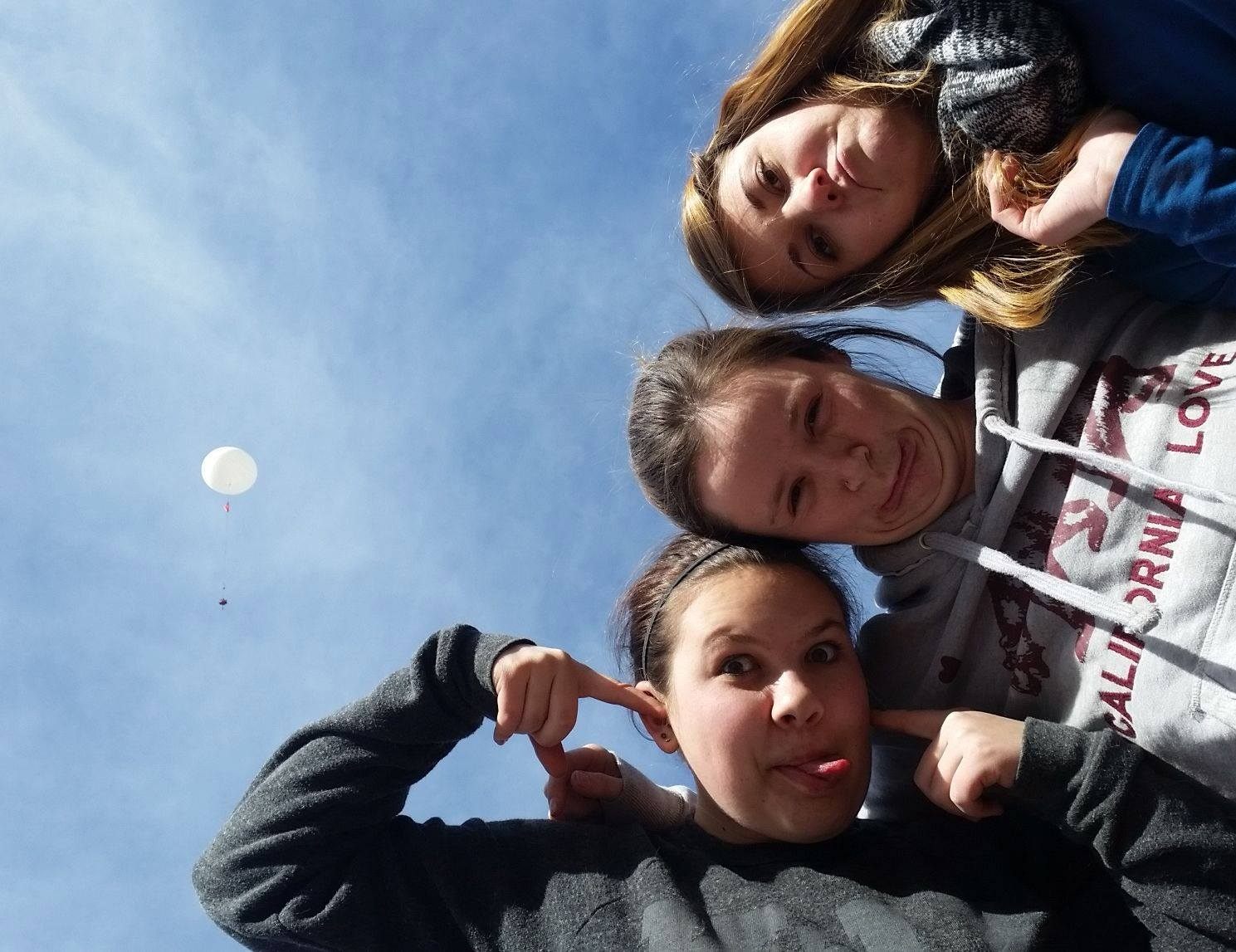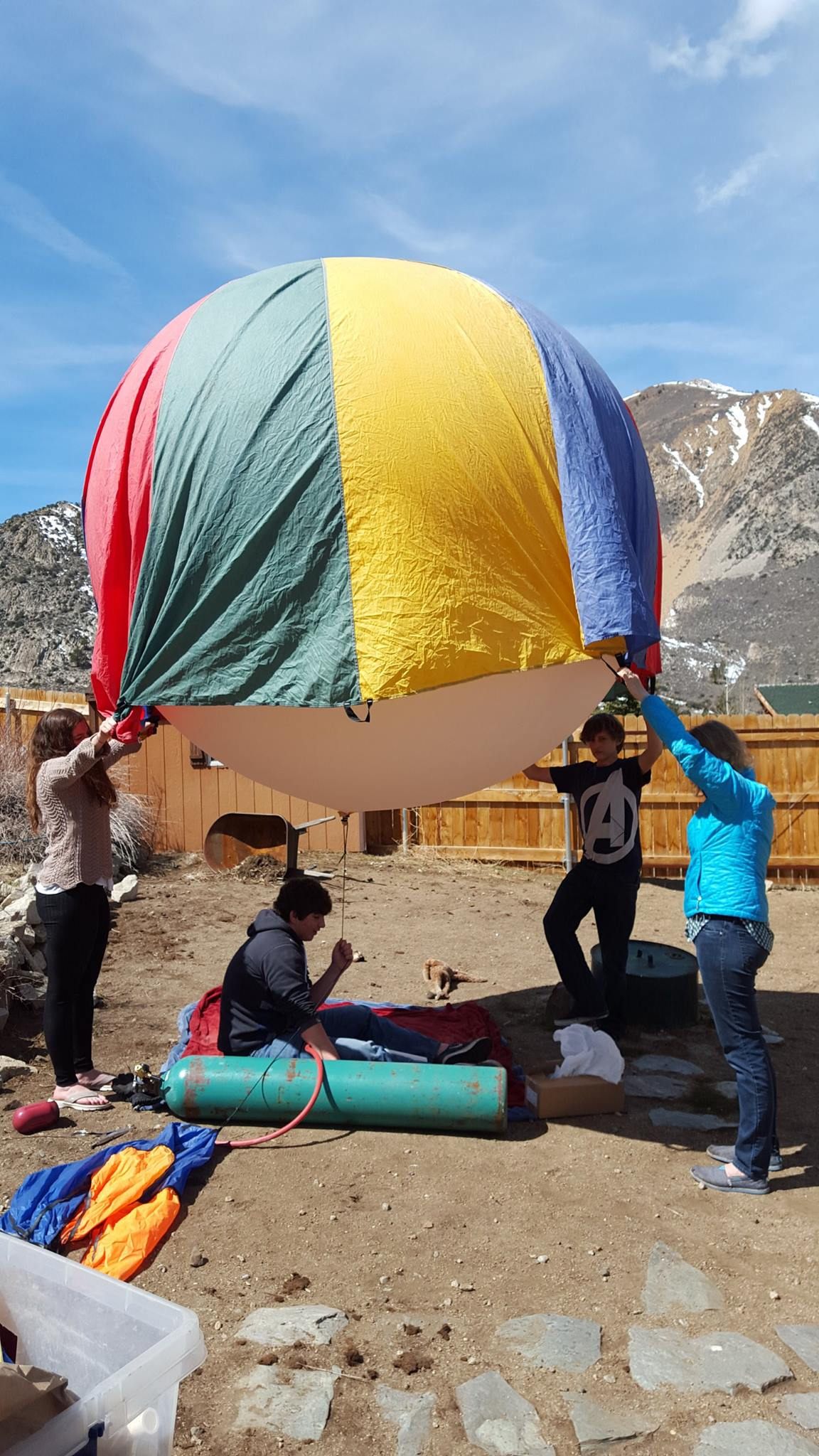The California Teens Reinventing the Science of Space Ballooning
The small-town high schoolers have turned their favorite after-school activity into a bonafide stratospheric research institute.

A trio of Earth to Sky Calculus members, with their handiwork in the background. (All photos: Earth to Sky Calculus)
Just after the 2012 election, a couple of hikers in California’s Sierra Nevada Mountains saw a small object crash-land a little off the trail. When they chased it down, they found some strange detritus: two candidate bobbleheads, one Obama and one Romney, strapped to a lunchbox along with a GoPro, and in pieces from its recent descent. “What is this?! It fell out of space!” one shouted. The other grabbed Obama’s head off the ground: “I don’t know, but these people are sick!”
As they will proudly inform you, the sick people in question are Earth to Sky Calculus—a group of high schoolers in Bishop, California who habitually dedicate their afterschool hours to making things fall out of space. They are incredibly good at designing, building, and launching stratospheric balloons, which are elephant-sized spheres packed with enough helium to carry small packages into the upper reaches of the atmosphere.
In the six years it has been in operation, Earth to Sky has successfully sent about 120 balloons to the edge of space. In the process, it has turned itself from a juiced-up chess club into a reputable research institute, collaborating with NASA and professional microbiologists and keeping itself afloat with spacey sponsorship deals.
“It was definitely not planned,” says Aaron Lamb, one of Earth to Sky’s founding members, and now a midshipman at the California Maritime Academy. “We didn’t sit down and form a Soviet-type committee that had a five-year plan for ballooning.” Instead, the club was the product of three equally potent, intersecting forces: A dedicated dad, teenage curiosity, and small-town boredom.
Dr. Tony Phillips, a former Caltech astrophysicist, had been teaching math and physics to his daughter and her classmates at lunchtime since they turned 10. When they tired of his lectures, he decided they should get into something more hands-on. Space ballooning seemed like a good place to start.
It was an inspired choice. A stratospheric balloon is the kind of research tool that stays exciting—prone to both soaring successes and dramatic pops, and flexible enough to absorb, and pay off, a certain level of craziness. Take their first flight: looking around for a vessel, the kids settled on one member’s lunchbox, says Lamb. They stuffed it with trackers, tied it to the huge balloon, and let it go.
Three Earth To Sky members, holding the balloon down until the right moment.
The spot trackers lost touch in midair, and when the balloon went down, the team had to scour the desert for hours. “When we found it we were so happy, we were dancing around,” says Lamb. Way better than lunch.
These days, the operation is slightly slicker. They still use lunchboxes, which turned out to be great temperature-regulators, but their contents are more considered. For one thing, the high schoolers have started taking on university-level research projects, delivering payloads to and from the edge of space so efficiently that scientists seek them out.
“They’re experts,” says Dr. Shiladitya DasSarma, a researcher at the University of Maryland School of Medicine who has used Earth to Sky as an atmospheric courier service. DasSarma studies extremophiles—microbes that thrive at far-out temperatures, pressures, and radiation levels—and wanted to see how well they could hack it in the stratosphere, which is a good analogue for the surface of Mars. DasSarma’s microbes survived the journey, and made it back to his lab in less time than it takes to FedEx something across Bishop, says Lamb.

Too windy to launch.
The students have also developed their club into a profit-turning LLC, and some of their launches are dedicated to high-altitude fundraising. There are “Visit Space!”-style sponsor deals: companies and individuals have hired Earth to Sky to float up business cards, sports drinks, and roof tiles. There are holiday promotions—for $49.95, you can buy your mom a pressed “space rose,” part of a bouquet that spent some time at 116,000 feet. In order to give sponsors more bang for their buck, the students have tricked out some of their lunchboxes, enabling them to mount GoPros at crazy angles. Lamb estimates they’ve raised $40,000 from sponsorships.
Even at five figures, the process never gets any less goofy. The members of Earth to Sky are serious scientists and businesspeople, but they’re also teens. They haze new members by making them lay underneath the balloon, wrestling it down as it strains at its tether. They swap war stories about 20-hour retrievals, and the time one particular junior had to go out and fetch the lunchbox alone, while the seniors were at prom.
Two years after graduating, Lamb calls Dr. Phillips “boss” and his fellow original team members “The Magnificent Seven.” When telling the bobblehead story, he can hardly keep it together. (After that launch, they released a video of the Obama bobblehead spinning through the air and headbanging to Coheed and Cambrida.)
There is one difference, though—they’ve have stopped dancing when they track down the lunchbox. “[Dr. Phillips] gets nostalgic nowadays that no one dances,” says Lamb. “He keeps saying, ‘I wish you kids would still jump up and down when we launch the balloon.’ And we say ‘Boss, we’re 20 now.’”











Follow us on Twitter to get the latest on the world's hidden wonders.
Like us on Facebook to get the latest on the world's hidden wonders.
Follow us on Twitter Like us on Facebook